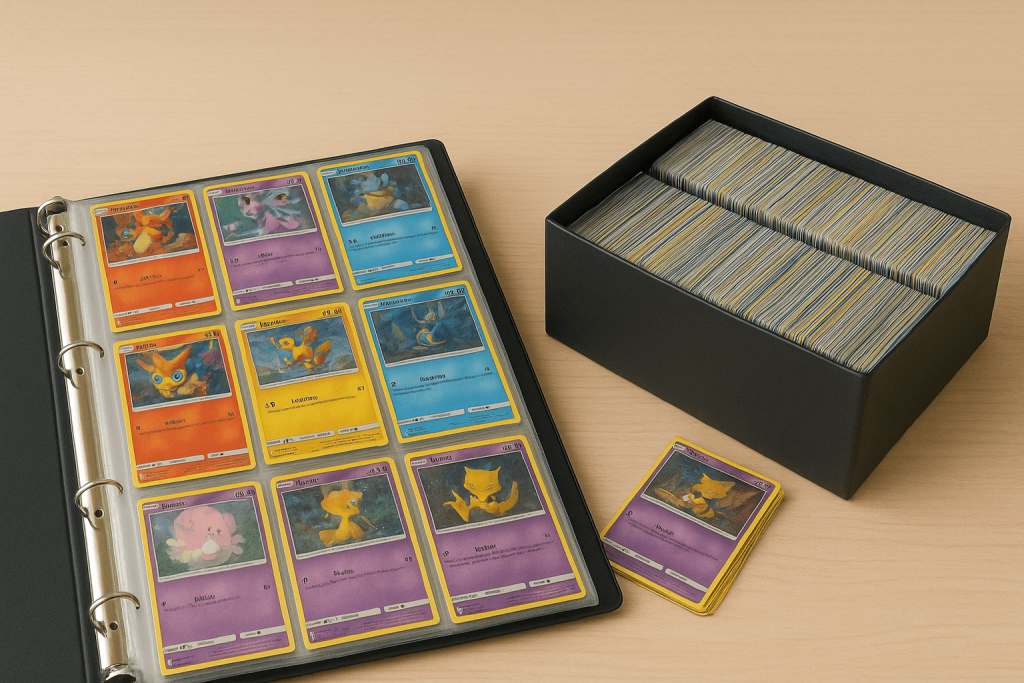How to Organize Your Pokémon Card Collection
Whether you’re a long-time collector or just getting started, keeping your Pokémon cards organised makes a huge difference. Not only does it protect your cards from damage, but it also helps you enjoy your collection, trade more effectively, and even keep track of valuable cards.
In this guide, we’ll cover how to organise your Pokémon card collection step by step, with tips that work for beginners and serious collectors alike.
1. Decide on Your Organising Style
Before you start sorting, think about how you want to display or store your cards. Some popular ways include:
-
By Set: Perfect for collectors who want to complete entire expansions.
-
By Type: Group cards by Energy type (Fire, Water, Grass, etc.).
-
By Rarity: Keep common, uncommon, rare, and ultra-rare cards separated.
-
By Value: Protect high-value or graded cards in a separate case.
-
By Personal Preference: Some collectors arrange by favourite Pokémon or artwork.
💡 Tip: If you plan to sell or trade, organising by set and number makes it easier to identify cards quickly.
2. Use Binders for Display and Easy Access
Binders are the most popular way to organise cards, especially for collectors who love flipping through their collection.
-
Use 9-pocket pages with acid-free sleeves to prevent damage.
-
Sort cards numerically by set so they’re easy to track.
-
Place high-value cards in double sleeves before putting them in the binder for extra protection.
💡 Tip: Store binders upright like books to prevent bending.
3. Storage Boxes for Bulk Cards
Not every card needs to go in a binder. Bulk commons and duplicates are best stored in card storage boxes.
-
Use 500–5000 card capacity boxes for bulk storage.
-
Label boxes by set or type for quick access.
-
Keep them in a cool, dry place away from sunlight and humidity.
💡 Tip: Use dividers inside the boxes to separate sets or types.
4. Protect Valuable Cards with Toploaders or Cases
Ultra-rare and high-value cards deserve extra care.
-
Use toploaders or magnetic cases for individual protection.
-
Consider grading services (like PSA or Beckett) for cards worth significantly more.
-
Never keep rare cards loose in a binder without sleeves—they’ll scratch easily.
5. Create a Digital Inventory
Tracking your collection digitally helps you stay organised, especially if you trade or sell.
-
Use apps like Pokellector or TCGplayer to log your cards.
-
Create a spreadsheet with card name, set, condition, and value.
-
Update regularly after trades or purchases.
💡 Tip: This also helps you avoid buying duplicates of cards you already own.
6. Maintain Your Collection Over Time
Organisation is an ongoing process. Make it a habit to:
-
Sort new cards as soon as you get them.
-
Check your storage every few months for humidity or bending issues.
-
Reorganise if your collecting style changes (for example, from casual to competitive focus).
Conclusion
Learning how to organise your Pokémon card collection not only keeps your cards safe but also makes collecting more enjoyable. Whether you use binders, boxes, or digital inventories, the key is consistency. With a little effort, you’ll have a collection that’s protected, easy to navigate, and ready to show off or trade anytime.


